A Comparative Study of Methanol and Methane Combustion in a Gas Turbine Combustor
Abstract
:1. Introduction
2. Numerical Methods
2.1. Governing Equations
2.2. Tubulence Model, Combustion Model, and NOx Model
2.3. Combustor Efficiency and Outlet Temperature Distribution Factor
3. Combustor Geometry and Numerical Set
3.1. Combustor Geometry and Mesh Generation
3.2. Boundary Conditions
3.3. Swirler Geometry
3.4. Cases Under Different PFRs
3.5. Validation of the Numerical Methods
4. Results and Discussion
4.1. Outlet Velocity Distributuion
4.2. Oulet Temperature Distribution
4.3. Outlet Temperature Distribution Factor
4.4. Combustor Efficiency
4.5. NOx Emission
5. Conclusions
- The outlet parameters of the methanol combustor are comparable to those of the methane combustor, yet the combustor’s efficiency is superior. The difference between the average outlet velocity of methanol and methane is less than 1%; the difference in temperature between the two fuels is less than 1%; and the OTDF is similar to that of methane. The combustor efficiency of methanol (99.52–99.89%) is 0.2–0.3% higher than that of methane (99.33–99.61%). The oxygenated nature of methanol is the key mechanism for improving efficiency by inhibiting incomplete diffusion combustion.
- NOx emission control of methanol achieves significant advantages in two main aspects. Under all operating conditions, NOx emissions from methanol combustion are only 40–78% of those from methane combustion, with the lowest emission value (51.53 ppm) occurring at a PFR of 2%. In contrast, methane combustion reaches its lowest NOx emission value (93 ppm) at a PFR of 4%. The emission advantages are as follows: (1) Temperature control: the low adiabatic flame temperature of methanol suppresses thermal NOx formation, which is dominated by the Zeldovich mechanism. (2) Optimisation of air utilisation: The oxygenated nature of methanol reduces the oxygen demand in the main combustion zone. Excess air improves cooling in the high-temperature area, thereby widening the low-emission window (methanol: PFR = 1–12%; methane: PFR = 2–4%).
Author Contributions
Funding
Data Availability Statement
Conflicts of Interest
Abbreviations
| CFD | Multidisciplinary Digital Publishing Institute |
| PFR | Pilot fuel ratio |
| OTDF | Outlet temperature distribution factor |
References
- Zhang, B.; Chen, Y.; Wang, Z.; Shakibi, H. Thermodynamic, environmental, and optimization of a new power generation system driven by a gas turbine cycle. Energy Rep. 2020, 6, 2531–2548. [Google Scholar]
- Wu, D.W.; Wang, R.Z. Combined cooling, heating and power: A review. Prog. Energy Combust. Sci. 2006, 32, 459–495. [Google Scholar]
- Liu, Y.; Sun, X.; Sethi, V.; Nalianda, D.; Li, Y.G.; Wang, L. Review of modern low emissions combustion technologies for aero gas turbine engines. Prog. Aerosp. Sci. 2017, 94, 12–45. [Google Scholar]
- Budiyanto, M.A.; Nawara, R. The optimization of exergoenvironmental factors in the combined gas turbine cycle and carbon dioxide cascade to generate power in LNG tanker ship. Energy Convers. Manag. 2020, 205, 112468. [Google Scholar]
- Faqih, M.; Omar, M.B.; Ibrahim, R.; Omar, B.A. Dry-Low Emission Gas Turbine Technology: Recent Trends and Challenges. Appl. Sci. 2022, 12, 10922. [Google Scholar] [CrossRef]
- Liu, M.; Shi, Y.; Fang, F. Combined cooling, heating and power systems: A survey. Renew. Sustain. Energy Rev. 2014, 35, 1–22. [Google Scholar]
- Pilavachi, P.A. Power generation with gas turbine systems and combined heat and power. Appl. Therm. Eng. 2000, 20, 1421–1429. [Google Scholar]
- Dennis, R.; Long, H.A.; Jesionowski, G. A literature review of NOx emissions in current and future state-of-the-art gas turbines. J. Eng. Gas Turbines Power 2024, 146, 030801. [Google Scholar]
- Correa, S.M. A review of NOx formation under gas-turbine combustion conditions. Combust. Sci. Technol. 1993, 87, 329–362. [Google Scholar]
- Okafor, E.C.; Somarathne, K.K.; Ratthanan, R.; Hayakawa, A.; Kudo, T.; Kurata, O.; Iki, N.; Tsujimura, T.; Furutani, H.; Kobayashi, H. Control of NOx and other emissions in micro gas turbine combustors fuelled with mixtures of methane and ammonia. Combust. Flame 2020, 211, 406–416. [Google Scholar]
- Ma, Y.; Liu, J.; Zhu, L.; Li, Q.; Guo, Y.; Liu, H.; Yu, D. Multi-objective performance optimization and control for gas turbine Part-load operation Energy-saving and NOx emission reduction. Appl. Energy 2022, 320, 119296. [Google Scholar]
- Chen, A.G.; Maloney, D.J.; Day, W.H. Humid Air NOx Reduction Effect on Liquid Fuel Combustion. In Proceedings of the ASME Turbo Expo, Amsterdam, The Netherlands, 3–6 June 2002. [Google Scholar]
- Holdeman, J.D.; Chang, C.T. Low Emissions RQL Flametube Combustor Component Test Results; NASA/TM-2001-210678; NASA: Cleveland, OH, USA, 2001. [Google Scholar]
- Beck, C.H.; Koch, R.; Bauer, H.J. Investigation of the Effect of Incomplete Droplet Prevaporization on NOx Emissions in LDI Combustion Systems. J. Eng. Gas Turbines Power 2008, 130, 218–230. [Google Scholar]
- Spadaccini, C.M.; Peck, J.; Waitz, I.A. Catalytic Combustion Systems for Micro-Scale Gas Turbine Engines. J. Eng. Gas Turbines Power 2007, 129, 49–60. [Google Scholar]
- Wang, W.; Xiao, J.F.; Gao, S.; Wang, F.; Li, X.F.; Hu, M.Q. Numerical Study on Influences of Air-Fuel Ratio on Combustion Instability in Gas Turbine Combustor. J. Combust. Sci. Technol. 2019, 25, 439–444. [Google Scholar]
- Shen, W.; Liu, L.; Hu, Q.; Liu, G.; Wang, J.; Zhang, N.; Wu, S.; Qiu, P.; Song, S. Combustion Characteristics of Ignition Processes for Lean Premixed Swirling Combustor under Visual Conditions. Energy 2021, 218, 119521. [Google Scholar]
- Zhang, Y.; Wang, J.; Liu, Y.; Yan, Y. Numerical simulation of the influence of fuel allocation method on regional NOx production in a single sector combustor. Energy 2023, 270, 126923. [Google Scholar]
- Zong, C.; Lyu, Y.; Guo, D.; Li, C.; Zhu, T. Experimental and numerical study on emission characteristics of the double annular swirler under different pilot fuel ratios. In Proceedings of the ASME Turbo Expo: Power for Land, Sea, and Air, Oslo, Norway, 11–15 June 2018. [Google Scholar]
- Zong, C.; Ji, C.; Cheng, J.; Zhu, T. Effects of Pilot Fuel Ratio on Combustion Process: Flow Field Structure and Pollutant Emissions. J. Therm. Sci. 2023, 32, 2321–2335. [Google Scholar]
- Glaude, P.A.; Sirjean, B.; Fournet, R.; Bounaceur, R.; Vierling, M.; Montagne, P.; Molière, M. Combustion and oxidation kinetics of alternative gas turbines fuels. In Proceedings of the ASME Turbo Expo: Power for Land, Sea, and Air, Düsseldorf, Germany, 16–20 June 2014. [Google Scholar]
- Levy, Y.; Erenburg, V.; Roizman, A.; Sherbaum, V. Numerical and Experimental Study of the Emissions During Methanol Combustion. In Proceedings of the ASME Turbo Expo: Power for Land, Sea, and Air, Oslo, Norway, 11–15 June 2018. [Google Scholar]
- Von KleinSmid, W.H.; Schreiber, H.; Klapatch, R.D. Methanol combustion in a 26-MW gas turbine. In Proceedings of the ASME 1981 International Gas Turbine Conference and Products Show, Houston, TX, USA, 9–12 March 1981. [Google Scholar]
- Smith, K.O. Ultra-Low NOx Combustor Concept for Methanol Firing. In Proceedings of the ASME Turbo Expo: Power for Land, Sea, and Air, Phoenix, AZ, USA, 27–31 March 1983. [Google Scholar]
- Chudnovsky, B.; Reshef, M.; Talanker, A. Evaluation of methanol and light fuel oil blends firing at a 50 MW gas turbine. In Proceedings of the ASME Power Conference 2017, Charlotte, CA, USA, 26–30 June 2017. [Google Scholar]
- Hain, Y.; Chudnovsky, B.; Talanker, A.; Kunin, A.; Rappoport, N.; Reshef, M.; Shternshus, M.; Baitel, S. Methanol fuel as low cost alternative for emission reduction in gas turbines and utility boilers. In Proceedings of the 20th International Conference on Nuclear Engineering, Anaheim, CA, USA, 30 July–3 August 2012. [Google Scholar]
- Chudnovsky, B.; Reshef, M.; Keren, M.; Baitel, S. Successful Implementation of Methanol Firing at 50 MW Gas Turbine for Long Term Operation. In Proceedings of the ASME Power Conference 2015, San Diego, CA, USA, 28 June–2 July 2015. [Google Scholar]
- Tsang, W. Chemical Kinetic Data Base for Combustion Chemistry. Part 2. Methanol. J. Phys. Chem. Ref. Data 1987, 16, 471–508. [Google Scholar] [CrossRef]
- Egolfopoulos, F.N.; Du, D.X.; Law, C.K. A Comprehensive Study of Methanol Kinetics in Freely-Propagating and Burner-Stabilized Flames, Flow and Static Reactors, and Shock Tubes. Combust. Sci. Technol. 1992, 83, 33–75. [Google Scholar]
- Yarasai, S.S.; Ravi, D.; Yoganand, S.; Rajagopal, T.K. Numerical investigation on the performance and combustion characteristics of a cavity based scramjet combustor with novel strut injectors. Int. J. Hydrogen Energy 2023, 48, 5681–5695. [Google Scholar]
- Ji, C.; Shi, W.; Ke, E.; Cheng, J.; Zhu, T.; Zong, C.; Li, X. Numerical Investigations on the Effects of Dome Cooling Air Flow on Combustion Characteristics and Emission Behavior in a Can-Type Gas Turbine Combustor. Aerospace 2024, 11, 338. [Google Scholar] [CrossRef]
- Feng, Y.; Li, X.; Ren, X.; Gu, C.; Lv, X.; Li, S.; Wang, Z. Influence of the turbulence model on the numerical predictions of cold turbulent flow in a heavy-duty gas turbine DLN combustor. Int. J. Therm. Sci. 2024, 196, 108735. [Google Scholar]
- Shih, T.H.; Liou, W.W.; Shabbir, A.; Yang, Z.; Zhu, J. A new k-ϵ eddy viscosity model for high Reynolds number turbulent flows. Comput. Fluids 1995, 24, 227–238. [Google Scholar]
- ANSYS, Inc. ANSYS Fluent Theory Guide; ANSYS, Inc.: Canonsburg, PA, USA, 2020; pp. 54–55. [Google Scholar]
- Chatterjee, D.; Datta, A.; Ghosh, A.K.; Som, S.K. Effects of inlet air swirl and spray cone angle on combustion and emission performance of a liquid fuel spray in a gas turbine combustor. J. Inst. Eng. 2004, 85, 41–46. [Google Scholar]
- Cho, H.C.; Lee, Y.K. Reactor performance with primary/secondary swirl intensity and direction in coal gasification process. Int. J. Energy Res. 2001, 25, 1151–1163. [Google Scholar]
- Majidi, K. CFD modeling of non-premixed combustion in a gas turbine combustor. In Proceedings of the Fluids Engineering Division Summer Meeting, Montreal, QC, Canada, 14–18 July 2002. [Google Scholar]
- Zettervall, N.; Fureby, C.; Nilsson, E.J.K. Evaluation of Chemical Kinetic Mechanisms for Methane Combustion: A Review from a CFD Perspective. Fuels 2021, 2, 210–240. [Google Scholar] [CrossRef]
- Xing, C.; Chen, X.; Qiu, P.; Liu, L.; Yu, X.; Zhao, Y.; Zhang, L.; Liu, J.; Hu, Q. Effect of fuel flexibility on combustion performance of a micro-mixing gas turbine combustor at different fuel temperatures. J. Energy Inst. 2022, 102, 100–117. [Google Scholar]
- Tang, C.; Yao, Q.; Jin, W.; Li, J.; Yan, Y.; Yuan, L. Effect of swirler geometry on the outlet temperature profile performance of a model gas turbine combustor. Appl. Therm. Eng. 2025, 260, 124946. [Google Scholar]
- Wang, K.; Li, F.; Zhou, T.; Wang, D. Numerical simulations on the effect of swirler installation angle on outlet temperature distribution in gas turbine combustors. Appl. Therm. Eng. 2024, 240, 122252. [Google Scholar]
- Wang, D.; Li, F.; Lin, H.; Zhou, T.; Zhao, K. Research on substitutability of single-dome versus triple-dome center staged combustor. Case Stud. Therm. Eng. 2024, 60, 104633. [Google Scholar]
- Sun, J.; Yang, Q.; Zhao, N. Numerically study of CH4/NH3 combustion characteristics in an industrial gas turbine combustor based on a reduced mechanism. Fuel 2022, 327, 124897. [Google Scholar] [CrossRef]
- Wang, Q.; Fan, W.; Yi, J. Effect of rear blunt body structure and inlet conditions on the flow and combustion characteristics of an advanced vortex combustor for a gas turbine. Appl. Therm. Eng. 2025, 259, 124963. [Google Scholar] [CrossRef]
- Hu, G.; Qin, Q.; Jin, W.; Li, J. Large eddy simulation of the influences of the pilot-stage structure on the flow characteristics in a centrally staged high-temperature-rise combustor. Aerospace 2022, 9, 782. [Google Scholar] [CrossRef]
- Liu, W.; Yang, Q.; Xue, R.; Wang, H. Large eddy simulation study of flow dynamics in a multiswirler model combustor at elevated pressure and high temperature. J. Therm. Sci. Eng. Appl. 2019, 11, 061019. [Google Scholar] [CrossRef]
- Mongia, H. Recent progress in comprehensive modeling of gas turbine combustion. In Proceedings of the 46th AIAA Aerospace Sciences Meeting and Exhibit, Reno, NV, USA, 7–10 January 2008; American Institute of Aeronautics and Astronautics: Reston, VA, USA, 2008; p. 1445. [Google Scholar]
- Chudnovsky, B.; Livshits, D.; Baitel, S. Burning methanol and its blends attractive alternative for emission reduction. In Proceedings of the ASME Power Conference 2016, Charlotte, NC, USA, 26–30 June 2016. [Google Scholar]
- Huang, Y.; Lin, Y.Z. Combustion and Combustor; Beihang University Press: Beijing, China, 2009; Volume 9, pp. 300–301. [Google Scholar]
- Wulff, A.; Hourmouziadis, J. Technology review of aeroengine pollutant emissions. Aerosp. Sci. Technol. 1997, 1, 557–572. [Google Scholar] [CrossRef]


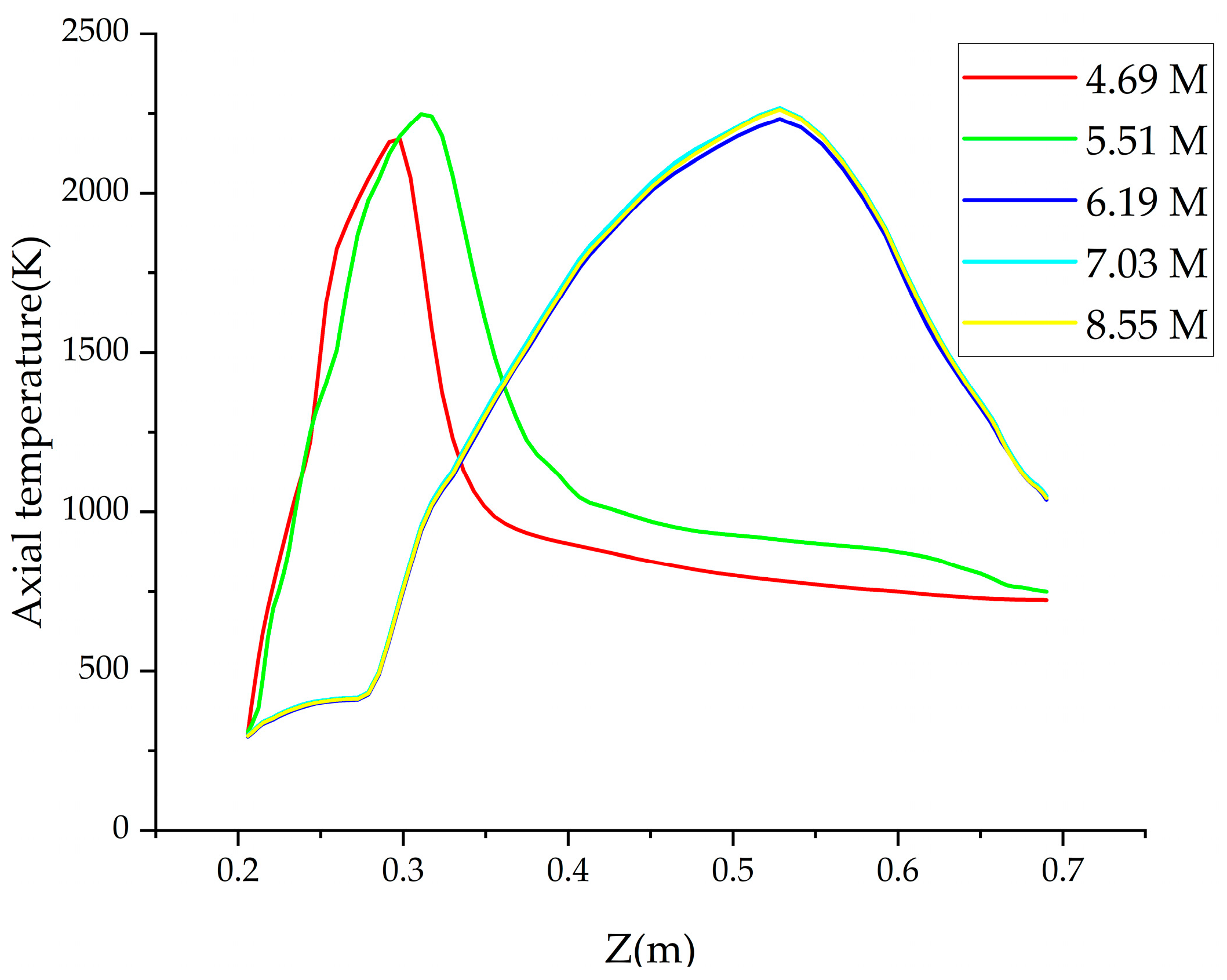

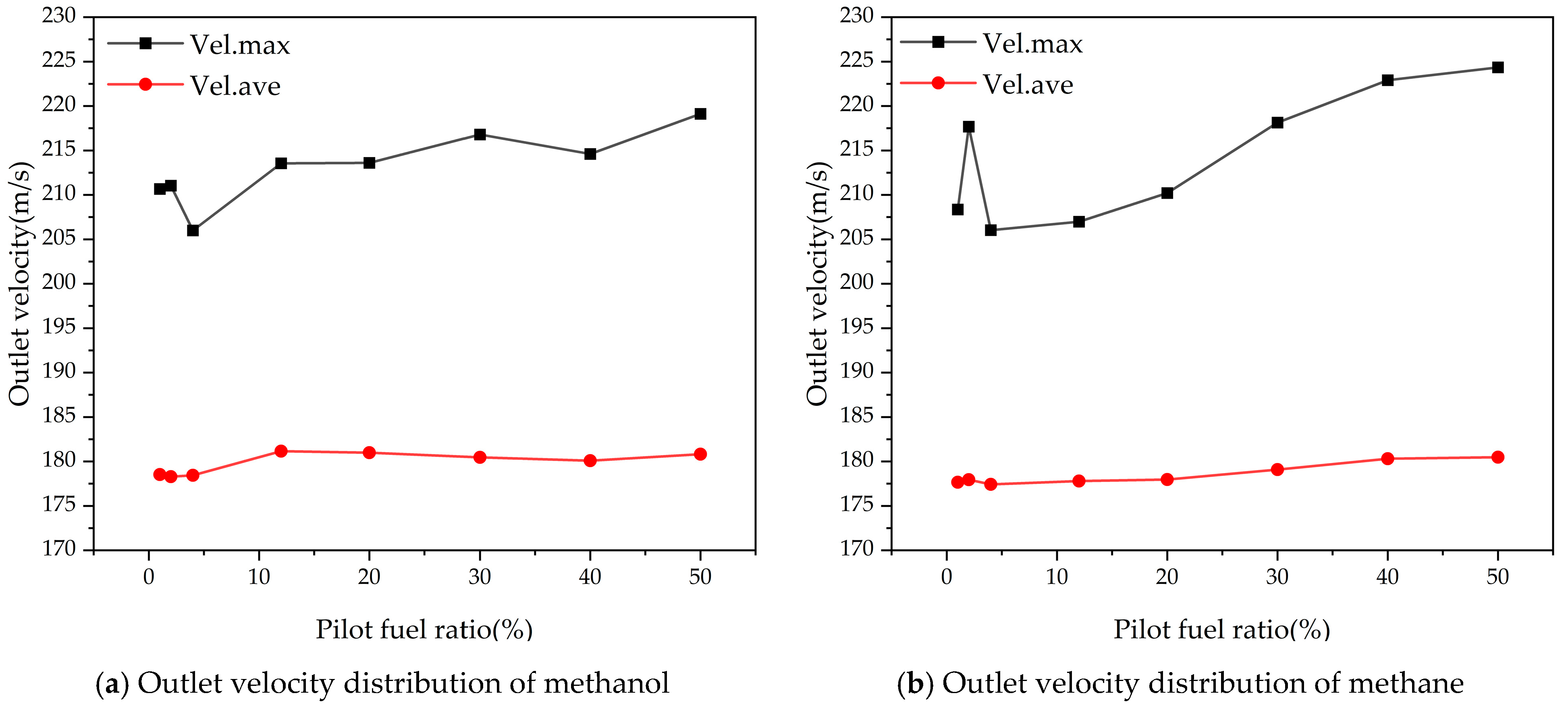
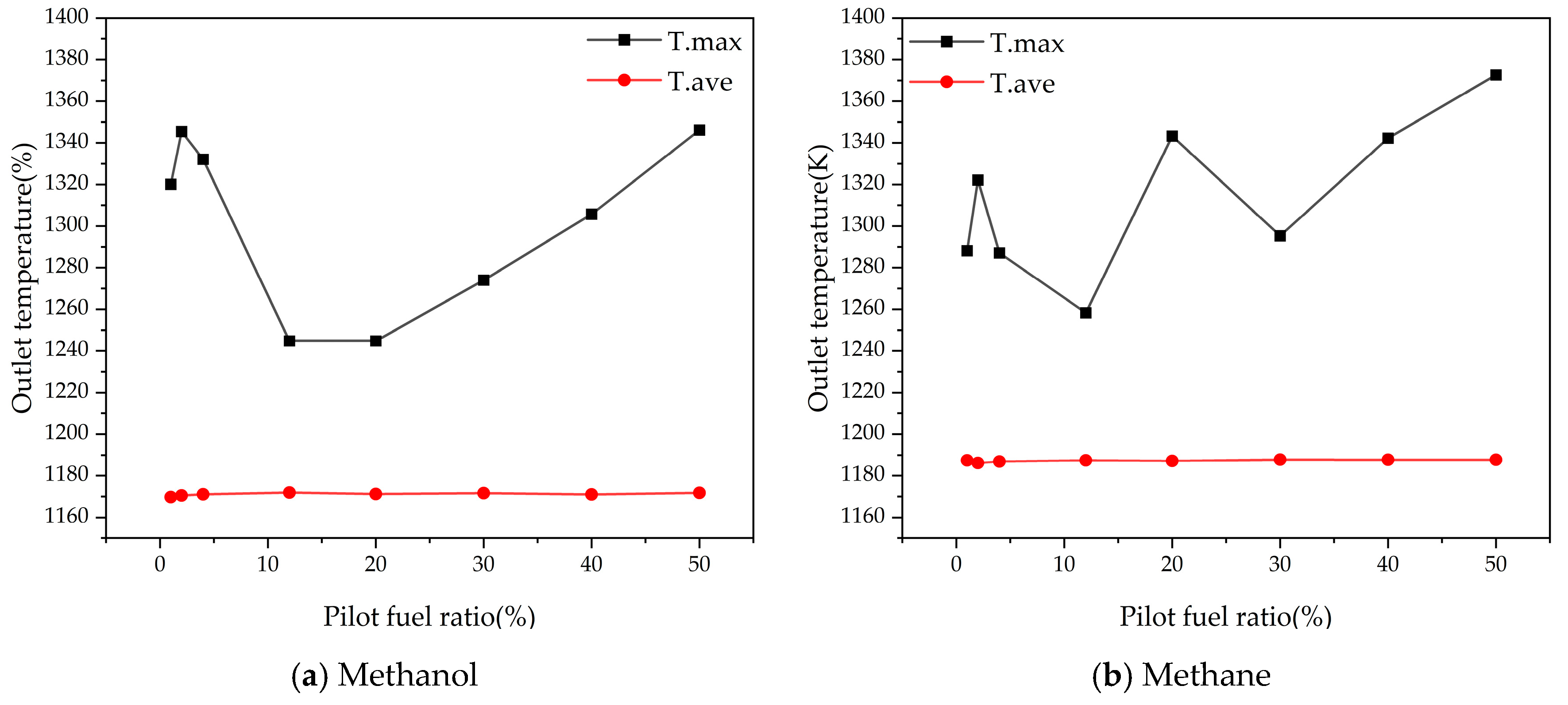
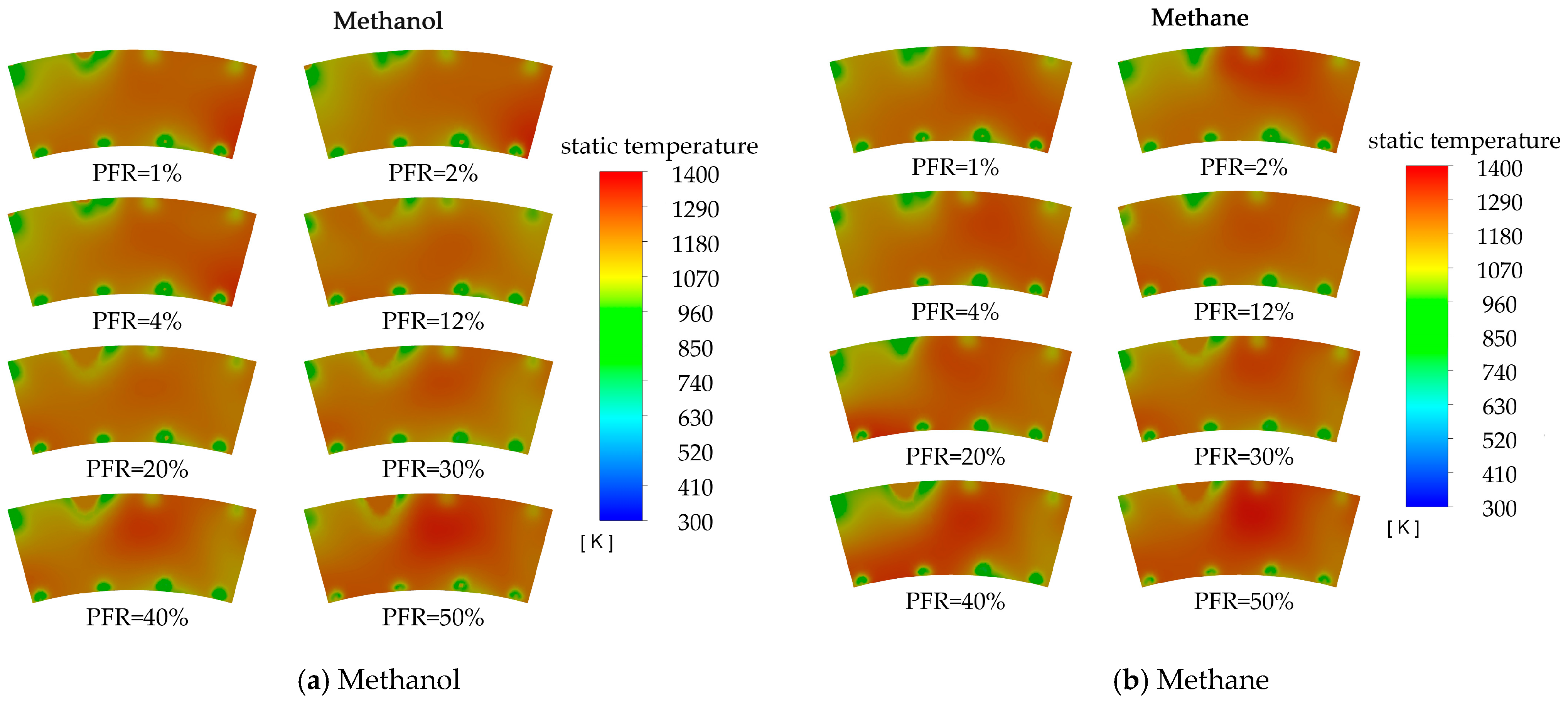

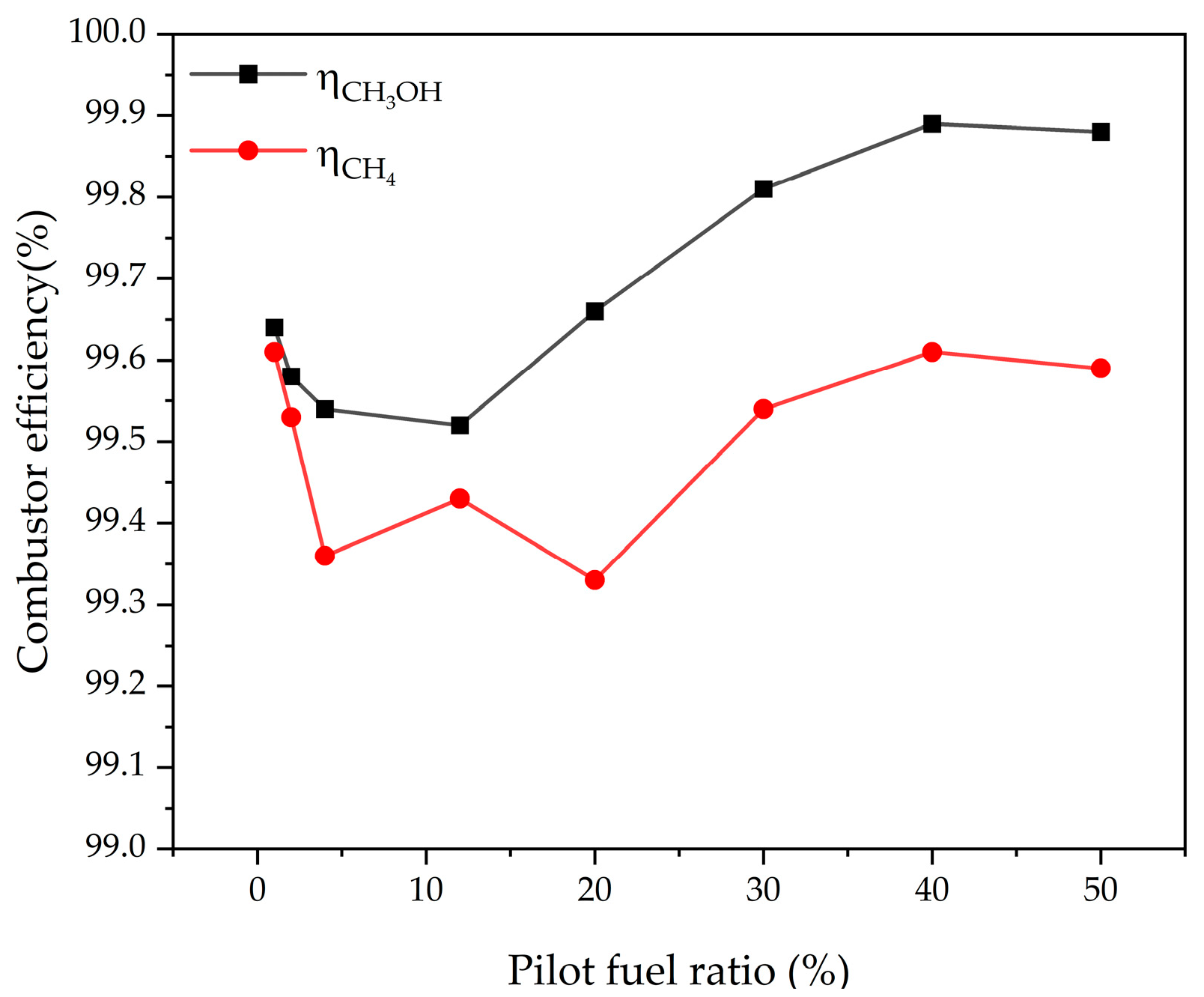
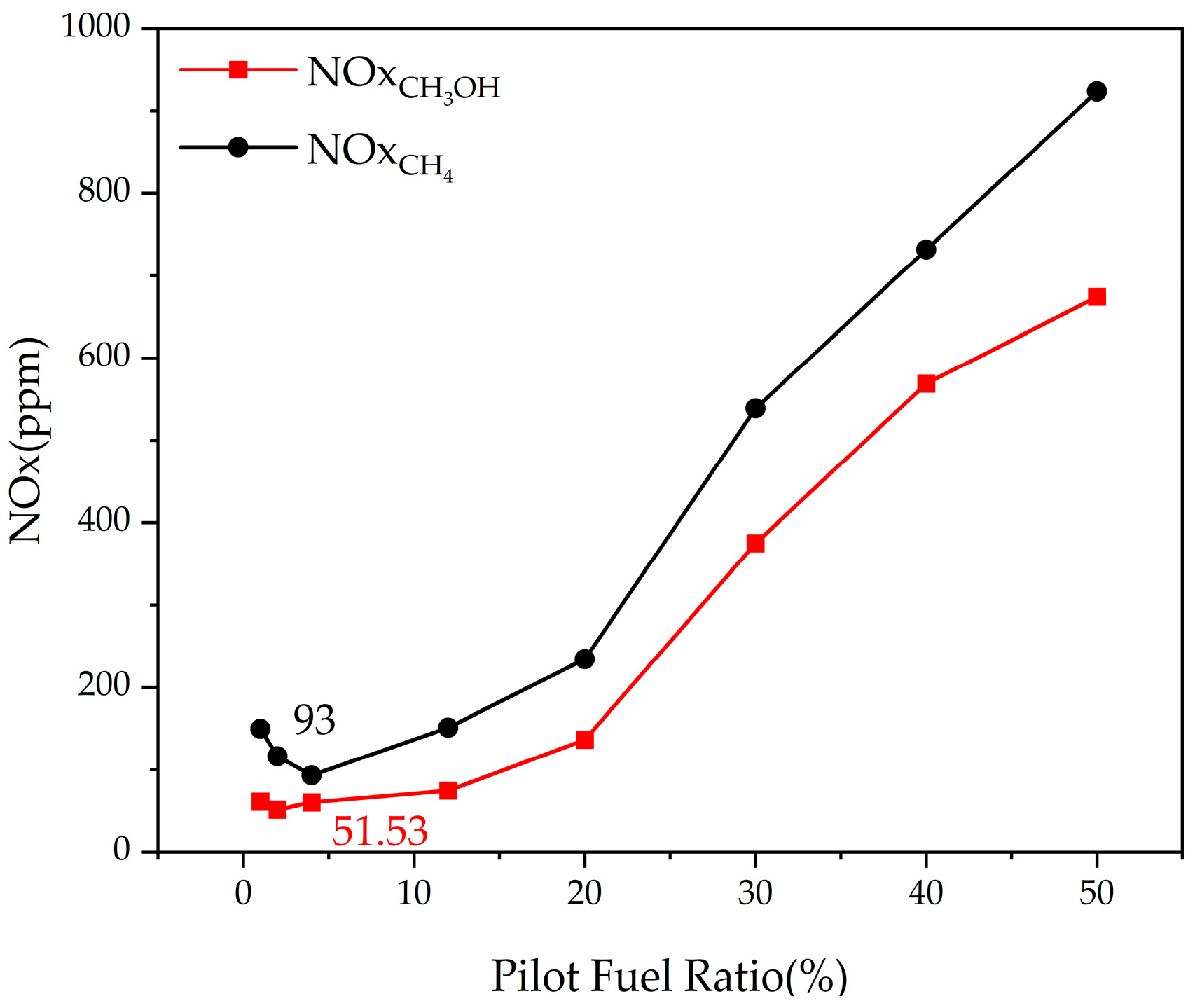

| Methane | Methanol | |
|---|---|---|
| Total fuel flow rate (kg/s) | 0.106 | 0.2156 |
| Inlet mass flow rate (kg/s) | 7.9 | 7.9 |
| Inlet total pressure (MPa) | 1.234 | 1.234 |
| Inlet total temperature (K) | 636 | 636 |
| Outlet total pressure (MPa) | 1.192 | 1.192 |
| Pilot Fuel Mass Flow Rate (kg/s) | Pilot Fuel Ratio (%) | |
|---|---|---|
| Case1 | 0.002 | 1 |
| Case2 | 0.005 | 2 |
| Case3 | 0.010 | 4 |
| Case4 | 0.030 | 12 |
| Case5 | 0.050 | 20 |
| Case6 | 0.076 | 30 |
| Case7 | 0.100 | 40 |
| Case8 | 0.126 | 50 |
| Pilot Fuel Mass Flow Rate (kg/s) | Pilot Fuel Ratio (%) | |
|---|---|---|
| Case9 | 0.001 | 1 |
| Case10 | 0.002 | 2 |
| Case11 | 0.004 | 4 |
| Case12 | 0.012 | 12 |
| Case13 | 0.021 | 20 |
| Case14 | 0.032 | 30 |
| Case15 | 0.042 | 40 |
| Case16 | 0.053 | 50 |
Disclaimer/Publisher’s Note: The statements, opinions and data contained in all publications are solely those of the individual author(s) and contributor(s) and not of MDPI and/or the editor(s). MDPI and/or the editor(s) disclaim responsibility for any injury to people or property resulting from any ideas, methods, instructions or products referred to in the content. |
© 2025 by the authors. Licensee MDPI, Basel, Switzerland. This article is an open access article distributed under the terms and conditions of the Creative Commons Attribution (CC BY) license (https://creativecommons.org/licenses/by/4.0/).
Share and Cite
Cui, J.; Yu, R.; Wang, H.; Wang, Y.; Tong, J. A Comparative Study of Methanol and Methane Combustion in a Gas Turbine Combustor. Energies 2025, 18, 1765. https://doi.org/10.3390/en18071765
Cui J, Yu R, Wang H, Wang Y, Tong J. A Comparative Study of Methanol and Methane Combustion in a Gas Turbine Combustor. Energies. 2025; 18(7):1765. https://doi.org/10.3390/en18071765
Chicago/Turabian StyleCui, Jiashuo, Rongguo Yu, Huishe Wang, Yangen Wang, and Jingze Tong. 2025. "A Comparative Study of Methanol and Methane Combustion in a Gas Turbine Combustor" Energies 18, no. 7: 1765. https://doi.org/10.3390/en18071765
APA StyleCui, J., Yu, R., Wang, H., Wang, Y., & Tong, J. (2025). A Comparative Study of Methanol and Methane Combustion in a Gas Turbine Combustor. Energies, 18(7), 1765. https://doi.org/10.3390/en18071765





